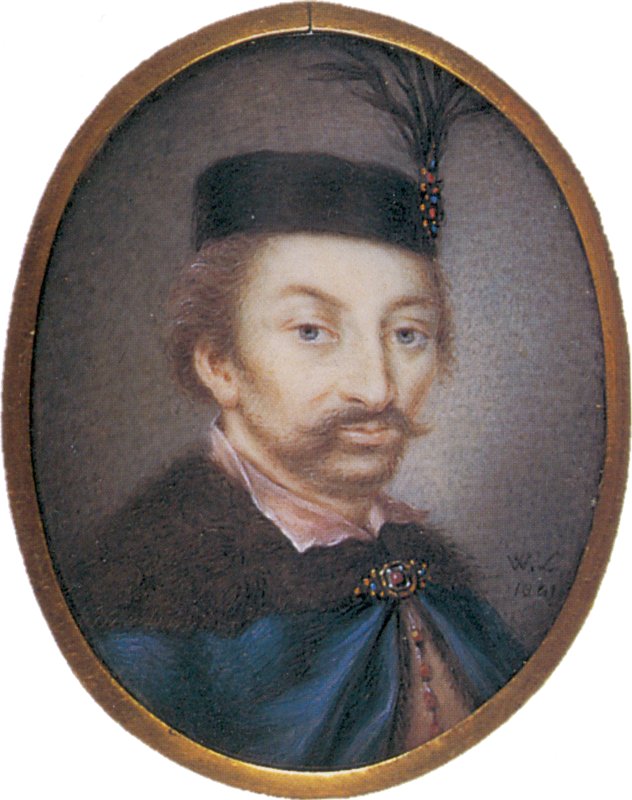- Stanisław Żółkiewski
Infobox Szlachcic
name=Stanisław Żółkiewski

caption=
family=Żółkiewski
CoA=Lubicz
father=Stanisław Żółkiewski (father)|Stanisław Żółkiewski
mother=Zofia Żółkiewska|Zofia née Lipska
consorts=Regina Żółkiewska|Regina née Herburt
children=Stanisław ŻółkiewskiKatarzyna Żółkiewska
born=1547
born_in=Turynka nearLwów ,Poland
death=October 7 ,1620
died_in=Battle of Ţuţora nearIaşi Stanisław Żółkiewski (1547 – 1620) was a Polish nobleman,
magnate and military commander. He was first European invader ofRussia to seizeMoscow and the only one who captured the capital of this country. [In 1812 Napoleon captured Moscow but actual Russian capital was thenSankt Petersburg .]He took part in many military operations both in Poland and on its southern and eastern border. He held a number of notable posts in the administration of the
Polish-Lithuanian Commonwealth , including thecastellan ofLwów (from 1590), voivod ofKijów Voivodship and Great Chancellor of the Crown (from 1618). Following 1588 he was also a Field CrownHetman , in 1613 promoted to Grand Hetman of the Crown. During his lifetime he won major military victories againstMuscovy , theOttoman Empire andTatars .Żółkiewski attended schools in Lwów, was well read and spoke foreign languages. He was secretary to King
Stefan Batory . Between 1594 and 1596 he defeated theCossack uprisng ofSeveryn Nalivaiko . In 1607 he defeated theZebrzydowski's Rebellion in thebattle of Guzów . In 1610 he achieved yet another brilliant victory in thebattle of Kłuszyn againstMuscovy . As an effect of his successful campaign, Żółkiewski seizedMoscow and has taken thetsar Vasiliy Shuyskiy captive during theDymitriads . He supported the election of Władysław IV Waza for tsar and the idea ofpersonal union between the Commonwealth and Muscovy.Since 1612 he was a teacher and tutor of
Stanisław Koniecpolski , future hetman and military commander. Both in 1612 and 1617 he commanded military campaigns to Moldavia (Moldavian Magnate Wars ) and Ukraine. Despite his old age (he was over 70), he continued his active service as a military commander until the very end.Żółkiewski was killed on
7 October ,1620 during the Polish retreat after thebattle of Cecora against the Turks inMoldova nearPrut river , during theMoldavian Magnate Wars . After the battle, his body was desecrated, his head cut off and sent to Constantinople as a war trophy. It was later bought by his widow, together with Żółkiewski's son who was taken captive during the battle. His body was buried in the family church inŻółkiew (now Zhovkva, Ukraine). His death gave rise to a veritable legend about the Christian knight slain by the pagans in defense of the Holy Faith [Mikoś, 1996]Works
* "Początek i progres wojny moskiewskiej" ("On the Beginning and the End of the Muscovite War", also known as "Beginning and Progress of the Muscovy War") - memoires describing his campaigns and diplomatic activity, written in the third person, is a concise account of a
Polish-Muscovite War (1605-1618) .Notes
References
* "Hetmani Rzeczypospolitej Obojga Narodów"; Bellona,
Warsaw , 1994 ISBN 8311082758
*Michael J. Mikoś , "Polish Baroque and Enlightenment Literature: An Anthology". Ed. Michael J. Mikoś. Columbus, Ohio/Bloomington, Indiana: Slavica Publishers. 1996. 104-108. ISBN 0893572667 (contains short bio and "Satire III: On Burdens and Oppressions of Peasants in Poland." )
Wikimedia Foundation. 2010.
